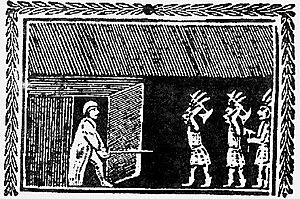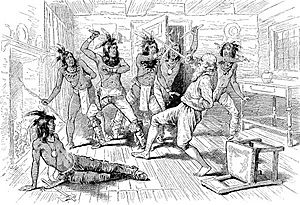Richard Waldron facts for kids
Quick facts for kids
Richard Waldron
|
|
|---|---|

Major Waldron defends against armed natives in the Cochecho Massacre of 1689
|
|
| President of New Hampshire | |
| In office 1681–1682 |
|
| Preceded by | John Cutt |
| Succeeded by | Edward Cranfield |
| Personal details | |
| Born |
Richard Walderne
6 January 1615 Alcester, Warwickshire, England |
| Died | 27 June 1689 (aged 74) Dover, Province of New Hampshire |
| Spouses | Unknown, Ann Scammon |
| Parents | William Walderne and Catherine Raven |
| Occupation | President of colonial New Hampshire, merchant, magistrate, councillor, mill owner, Major of the New Hampshire Militia and speaker of the colonial Massachusetts assembly |
| Signature |  |
Richard Waldron (1615–1689) was an important person in early colonial Dover, New Hampshire. He was born in England and became a successful merchant, soldier, and government official. His influence grew across New Hampshire and nearby Massachusetts. He served as the second president of the New Hampshire Royal Council after the area became separate from Massachusetts.
Richard Waldron was known as a very capable and determined leader from a wealthy family. He moved from England to what is now Dover, New Hampshire, around 1635. He built mills on the Cochecho River and gained a lot of land. He also managed much of the trade with local Native American groups. He was very active in local politics and served as a representative for Massachusetts for 25 years, even becoming the speaker several times. When the first president of the New Hampshire council, John Cutt, passed away, Waldron became the acting president, or governor, until Edward Cranfield arrived from England. By the 1670s, the area of Dover known as Cochecho was largely under Waldron's control.
Contents
Early Life and Family
Richard Waldron was born in Alcester, Warwickshire, England. He was one of many children of William Walderne and Catherine Raven. He was christened on January 6, 1615. We don't know much about his early life or the name of his first wife. He later married Ann Scammon and had several children.
Challenges with Land Ownership
Because Richard Waldron owned a lot of land, he became involved in a legal dispute. This dispute was part of a larger effort to challenge all land ownership in colonial New Hampshire. The goal was to give control of the land to the descendants of John Mason. Mason was an early colonial governor who had been granted land in New Hampshire by the British crown.
Dealing with Quakers
In 1662, three Quaker missionaries named Ann Coleman, Mary Tompkins, and Alice Ambrose arrived in Dover. Quakers had different religious beliefs from the Puritans who lived there. Within a few weeks, the townspeople complained about the Quakers' teachings. As the local official, Waldron ordered them to be punished. They were tied behind a cart and forced to walk over 80 miles in the cold winter. As they passed through ten towns, they were publicly whipped.
However, Major Robert Pike stopped this harsh treatment in Salisbury, Massachusetts. He released the women, who then received medical help and left for Maine. This event is remembered in a poem by the American Quaker poet, John Greenleaf Whittier.
A Tricky Plan Against Native Americans
After King Philip's War, some Native Americans who were fleeing from the Massachusetts Bay Colony militia sought safety with the Abenaki tribe near Dover. The Massachusetts militia told Waldron to attack these Native Americans and hand over any fighters. Waldron believed he could capture them without a battle.
So, on September 7, 1676, he invited about 400 Native Americans—half local and half refugees—to take part in a pretend battle against the militia. After the Native Americans fired their guns, Waldron, with help from Charles Frost, took them prisoner. Waldron then sent the refugee fighters and those local Native Americans who strongly protested this betrayal to Boston. There, seven or eight leaders were found guilty and executed. The remaining captives were sold into slavery in other countries, mostly Barbados.
The local Native Americans were later released, but they never forgot Waldron's deception. They felt he had broken the rules of honor and hospitality. In 1683, Richard Waldron was appointed the main judge for New Hampshire.
The Cochecho Massacre
During King William's War, Native Americans sought revenge on Waldron for his actions during King Philip's War. This happened during the Cochecho Massacre in 1689. At that time, local Pennacook women were often allowed to stay overnight in the settlers' fortified homes in Dover. Some settlers worried about this practice, but Waldron dismissed their concerns.
However, their worries were justified. On the night of June 27, 1689, Native American women who seemed to be staying peacefully opened the doors of the homes to waiting armed warriors. In a single bloody afternoon, a quarter of the colonists in what is now downtown Dover were killed or captured. Twenty-three people were killed, and 29 were taken prisoner in this revenge attack. The elderly Waldron was specifically targeted and tortured, and his house was burned. Charles Frost, who had helped Waldron in the earlier trickery, was also attacked by Native Americans in 1697.
Waldron is buried in the Cochecho Burying Ground in Dover, also known as Waldron Cemetery.
Family's Continuing Influence
Richard Waldron's son, Richard, his grandson, Richard, and his great-grandson, Thomas Westbrook Waldron, all served as members of the Royal Council for the Province of New Hampshire. The family's influence in New Hampshire lessened after the American Revolution.
However, the Waldron family did not completely disappear. A descendant named Thomas Westbrook Waldron moved north to Canada and started a branch of the family there. Two other grandsons, Richard Russell Waldron and Thomas Westbrook Waldron (consul), were part of an important exploration trip called the Wilkes Expedition. They gave the family name to a cape in the Antarctic, a landmark in Hawaii, and an island in the San Juan Islands of Washington state. Other family members became a Major in the U.S. Marines and a college principal.
| Government offices | ||
|---|---|---|
| Preceded by John Cutt |
President of the Province of New Hampshire (acting) 1681–82 |
Succeeded by Edward Cranfield as Governor of the Province of New Hampshire |


